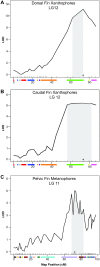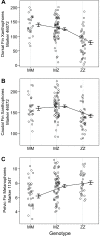Mapping of pigmentation QTL on an anchored genome assembly of the cichlid fish, Metriaclima zebra
- PMID: 23622422
- PMCID: PMC3691601
- DOI: 10.1186/1471-2164-14-287
Mapping of pigmentation QTL on an anchored genome assembly of the cichlid fish, Metriaclima zebra
Abstract
Background: Pigmentation patterns are one of the most recognizable phenotypes across the animal kingdom. They play an important role in camouflage, communication, mate recognition and mate choice. Most progress on understanding the genetics of pigmentation has been achieved via mutational analysis, with relatively little work done to understand variation in natural populations. Pigment patterns vary dramatically among species of cichlid fish from Lake Malawi, and are thought to be important in speciation. In this study, we crossed two species, Metriaclima zebra and M. mbenjii, that differ in several aspects of their body and fin color. We genotyped 798 SNPs in 160 F2 male individuals to construct a linkage map that was used to identify quantitative trait loci (QTL) associated with the pigmentation traits of interest. We also used the linkage map to anchor portions of the M. zebra genome assembly.
Results: We constructed a linkage map consisting of 834 markers in 22 linkage groups that spanned over 1,933 cM. QTL analysis detected one QTL each for dorsal fin xanthophores, caudal fin xanthophores, and pelvic fin melanophores. Dorsal fin and caudal fin xanthophores share a QTL on LG12, while pelvic fin melanophores have a QTL on LG11. We used the mapped markers to anchor 66.5% of the M. zebra genome assembly. Within each QTL interval we identified several candidate genes that might play a role in pigment cell development.
Conclusion: This is one of a few studies to identify QTL for natural variation in fish pigmentation. The QTL intervals we identified did not contain any pigmentation genes previously identified by mutagenesis studies in other species. We expect that further work on these intervals will identify new genes involved in pigment cell development in natural populations.
Figures




References
-
- Paripatananont T, Tangtrongpairoj J, Sailasuta A, Chansue N. Effect of astaxanthin on the pigmentation of goldfish Carassius auratus. J World Aquac Soc. 1999;30:454–460. doi: 10.1111/j.1749-7345.1999.tb00993.x. - DOI
Publication types
MeSH terms
LinkOut - more resources
Full Text Sources
Other Literature Sources
Miscellaneous

